Running an IT company is not easy. You have to comply with policies and procedures to assure your clients that their data is secure. During the audit, they need to track down based on the documented guidelines and policies.
Documented policies should be easily accessible to all employees, whether new or experienced, not only during the audit. Following rules, policies, and procedures in the workplace is integral to a healthy corporate culture.
Read on for more details about why your organization needs policies and procedures.
What are the IT policies and procedures?
IT policies and procedures are necessary for companies working in industries that deal with hardware and software. Any large organization is likely to have an IT department. This means that whatever systems you use should work together properly. By implementing proper policies, you can prevent system failures at critical moments.
Businesses like Document360 must operate within different regions, each with different laws regarding data governance. You may have heard of the GDPR (XX) or HIPAA (XX) and the way that it has affected business practices regarding user data, and how they operate in various regions.
We’ll explore how policies and procedures can help you with this.
Types of IT policies and procedures
WriteTheDocs is a great resource when it comes to learning the ropes of IT documentation. Documentation is anything that covers documenting the rules and processes that keep your organization running smoothly.
This rule applies whether you are a startup, a medium-sized business, or an enterprise. Systems scale as the business scales and any weak links in the chain will certainly break.
In short, you must get into good habits. Think of your software documentation as belonging to four types:
- Learning-oriented tutorials: something that will help users accomplish a task with your software task that guides them through a particular learning experience. Example: Whatfix.
- Goal-oriented how-to guides: helping users troubleshoot a particular problem concerning your system and get help without seeking support.
- Understanding-oriented discussions: helping users know what your product is about, what it is for, and generally how to use it.
- Information-oriented reference material: this type of documentation contains specs for your products, such as compatibility, functionality, system requirements, and more.
According to the Director of Engineering at Canonical, Daniele Procida, these are the only four types of software documents you need to create for your software product. Just as Splunk says, the product is the docs.
You may want to focus on reference documents to ensure the smooth running of your team, organization, or outsourcing partners. Daniele gave a great talk on this topic at #WriteTheDocs Prague 2017, and his information was outstanding.
To implement a successful knowledge management strategy, you need a dedicated knowledge base. A knowledge base is a website that contains your detailed policies and procedures.
Knowledge-based solutions like Document360 can help you achieve what Daniele seems to have achieved so naturally with his documents at Canonical. After a so-far prestigious career, he gives many great examples in his talk demonstrating how you can make any type of documentation more interesting.
That’s why you need a solution such as Document360 to help you create persuasive and engaging documentation. It’s a little like writing marketing copy, except it helps make the product work.
Documentation can be as visual as you like in Document360, and it works well even as you scale rapidly. You can log your IT policies and procedures in a Document360 knowledge base, which is suitable for technical writers in a hurry. Coding is not strictly required, but devs will find themselves right at home.
What is the difference between IT policies and procedures?
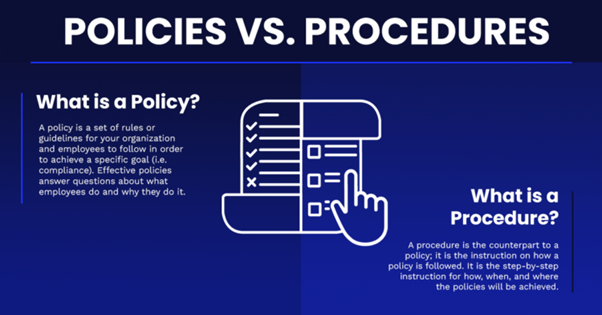
A policy is a set of rules that governs how a business operates, both internally with stakeholders and externally with customers or partners.
A procedure, in contrast, is a step-by-step set of instructions. Both are types of documentation, and you must use them together to create a coherent internal knowledge base. The organization must enforce policies and make sure employees follow the rules.
What can policies and procedures be used for?
If you’re operating a software company, you might use an API to connect your app with others. Software can communicate without directly sharing source code. This means you need comprehensive API documentation containing policies and procedures for your development partners learning your API.
If you are an IT help desk in a large governmental institution or educational body, you must follow your sector’s regulations.
When it comes to technology, it’s all about contextual relationships. In IT, if your software and hardware do not connect properly, the whole system might experience a lag, or completely fail. Implementing the correct policies and procedures helps guard against human error.
Also Read: Transforming Policy and Procedure Documentation: 3 Success Stories with Document360
The importance of IT policies and procedures
According to software company Splunk in their publication The Product is the Docs, they say “Teamwork is the dreamwork.” The Splunk documentation team explains that documentation must be collaborative rather than individualistic. Documenting your policies and procedures means you can work together better as a team.
Note that during Lockdown, the #WriteTheDocs community read this book as an effort to keep the technical editing spirit alive even amidst the trials of a pandemic. This shows the many powers and ways that documentation has of helping people and improving their lives.
Other ways that policies and procedures assist your team are:
- Securing Digital Assets: your digital assets are always prone to corruption, loss, contamination, or security risks. Its policies and procedures help you minimize risk when managing digital assets.
- Facilitate Employee Training and Awareness: each employee needs to be trained in the appropriate policies and procedures to execute their functions successfully.
- Safeguarding Compliance for Data Protection and Privacy: strict laws govern data storage, sharing, and transmission. Implementing policies and procedures helps your company abide by the law.
- Efficient Resource Allocation: When you thoroughly document each procedure, distributing the workload and assigning tasks is easier.
- Reference Point for Conflict Resolution: if there are any conflicts during business you can refer back to the documentation for a solution.
Schedule a demo with one of our experts to take a deeper dive into Document360
Book A Demo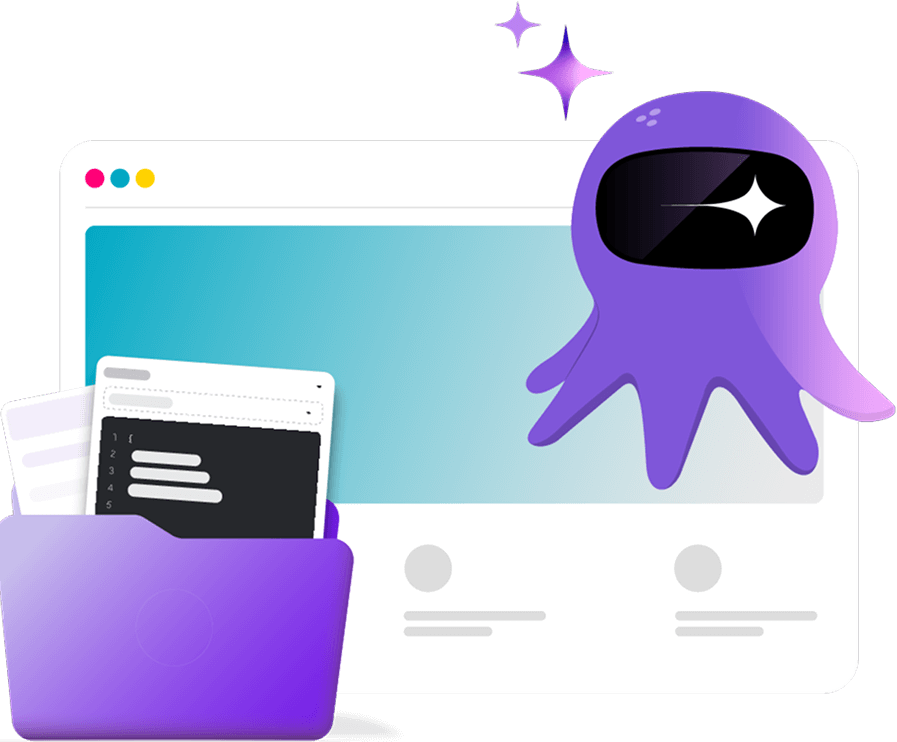
Best practices for writing IT Policies and Procedures
- Tailored Policies and Procedures to Organizational Needs: it can help you deal with the technical debt of your company if you document changes to the code right within the tool itself.
- Choose a tool that fits your requirements: consider budget, length of plan, and breadth of features when researching the current tools on the market.
- Maintain confidentiality, integrity, and availability: ensure robust security policies are in place when using SaaS to store sensitive data.
- Involve stakeholders and business owners: cross-team collaboration ensures that you can launch a system that suits your workflows and that will be adopted by your workforce.
- Provide Seamless Accessibility: Connecting your APIs with Logic Apps in Microsoft Azure can help ensure that everyone in your organization can access the systems when they need to,
- Regular Review and Updates: The right Knowledge Management system will schedule regular reviews and updates to help you ensure that content stays up-to-date.
Essential IT Policies and Procedures for Organizations
- Access Control Policy: defines the data security and governance standards within the organization.
- Data Protection and Privacy Policy: provide documentation for users about how their data will be handled and used for particular purposes.
- Software Management Policies: sets out the guidelines for how you will manage your software during development, maintenance, and shipping.
- IT Personnel Policies: provide instructions for employees about how to conduct themselves during business hours.
- Incident Response Procedures: provide an emergency plan to execute during a system error or implement a recovery.
- Backup and Disaster Recovery Procedures: a step-by-step recovery plan for protecting your data.
And check out the interface of our own Document360:
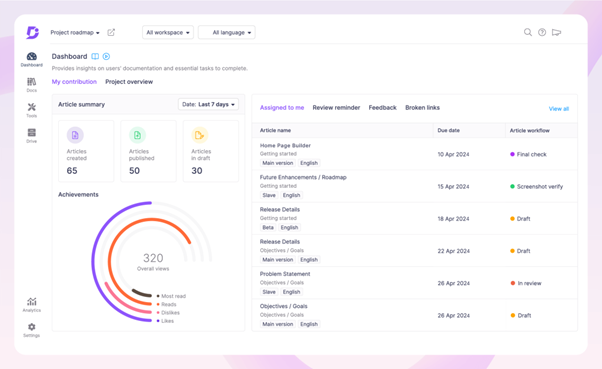
Also Read: Create Finance Policies and Procedure Manual
Get Started with IT Policies and Procedures Using Document360
Document360 quickly simplifies what could be a complicated process of managing your IT assets.
Creating IT policies and documentation with Document360 could not be easier. Sign up, make an account, and start your free trial. The plan you ultimately choose will depend on the size of your business, and budgetary requirements should be adjusted depending on the number of features you need and the complexity of your docs.
AI is fully integrated with the platform, as is our AI bot, Eddy. Eddy will help you create stunning documentation with the help of other knowledge tools, such as FreshChat or FullStory.
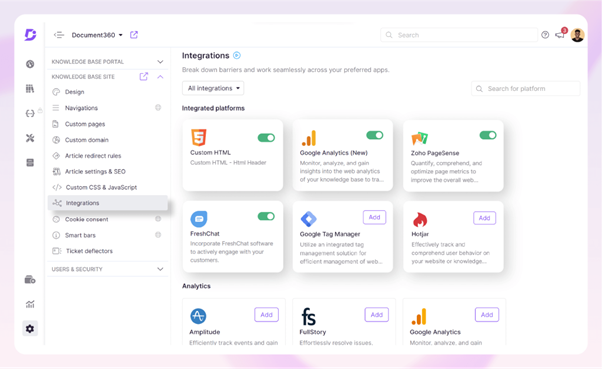
Sample of integrations for Document360
Final remarks
Document360 is an alternative solution that is dedicated to documentation and proper information architecture for your content.
This means your users will be happier when they can either search or browse the knowledge base. We use AI-powered Search with our AI assistant Eddy, to enhance user experience in searching the article, creating prompts, and more of the interactive Knowledge base. It will be too little if to not explore the full AI suite to understand AI features. That means you can rely on our robust tool stack for your sensitive and proprietary information.
In essence, everything in IT is interconnected. Systems must talk to each other in the same language, the same way people need to communicate. Policies and procedures help you achieve this.



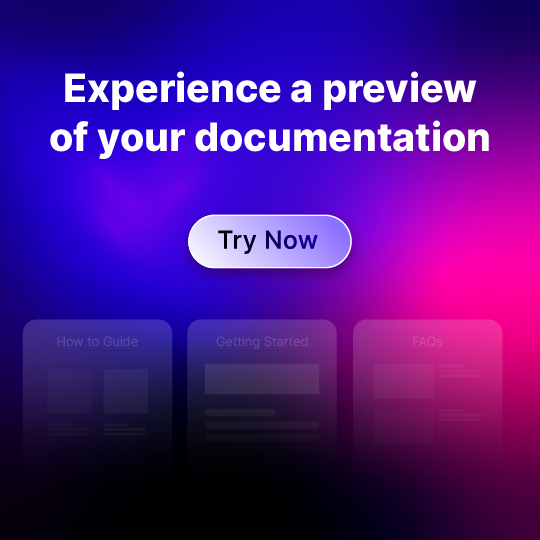
 –
– 

